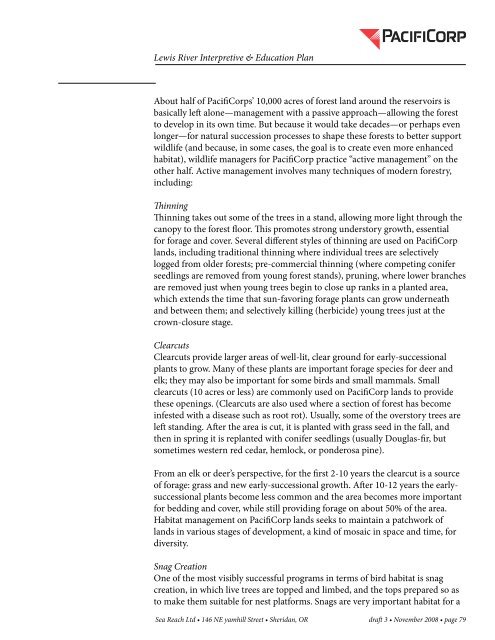The Lewis River Hydroelectric Projects - PacifiCorp
The Lewis River Hydroelectric Projects - PacifiCorp
The Lewis River Hydroelectric Projects - PacifiCorp
Create successful ePaper yourself
Turn your PDF publications into a flip-book with our unique Google optimized e-Paper software.
<strong>Lewis</strong> <strong>River</strong> Interpretive & Education Plan<br />
About half of <strong>PacifiCorp</strong>s’ 10,000 acres of forest land around the reservoirs is<br />
basically left alone—management with a passive approach—allowing the forest<br />
to develop in its own time. But because it would take decades—or perhaps even<br />
longer—for natural succession processes to shape these forests to better support<br />
wildlife (and because, in some cases, the goal is to create even more enhanced<br />
habitat), wildlife managers for <strong>PacifiCorp</strong> practice “active management” on the<br />
other half. Active management involves many techniques of modern forestry,<br />
including:<br />
Thinning<br />
Thinning takes out some of the trees in a stand, allowing more light through the<br />
canopy to the forest floor. This promotes strong understory growth, essential<br />
for forage and cover. Several different styles of thinning are used on <strong>PacifiCorp</strong><br />
lands, including traditional thinning where individual trees are selectively<br />
logged from older forests; pre-commercial thinning (where competing conifer<br />
seedlings are removed from young forest stands), pruning, where lower branches<br />
are removed just when young trees begin to close up ranks in a planted area,<br />
which extends the time that sun-favoring forage plants can grow underneath<br />
and between them; and selectively killing (herbicide) young trees just at the<br />
crown-closure stage.<br />
Clearcuts<br />
Clearcuts provide larger areas of well-lit, clear ground for early-successional<br />
plants to grow. Many of these plants are important forage species for deer and<br />
elk; they may also be important for some birds and small mammals. Small<br />
clearcuts (10 acres or less) are commonly used on <strong>PacifiCorp</strong> lands to provide<br />
these openings. (Clearcuts are also used where a section of forest has become<br />
infested with a disease such as root rot). Usually, some of the overstory trees are<br />
left standing. After the area is cut, it is planted with grass seed in the fall, and<br />
then in spring it is replanted with conifer seedlings (usually Douglas-fir, but<br />
sometimes western red cedar, hemlock, or ponderosa pine).<br />
From an elk or deer’s perspective, for the first 2-10 years the clearcut is a source<br />
of forage: grass and new early-successional growth. After 10-12 years the earlysuccessional<br />
plants become less common and the area becomes more important<br />
for bedding and cover, while still providing forage on about 50% of the area.<br />
Habitat management on <strong>PacifiCorp</strong> lands seeks to maintain a patchwork of<br />
lands in various stages of development, a kind of mosaic in space and time, for<br />
diversity.<br />
Snag Creation<br />
One of the most visibly successful programs in terms of bird habitat is snag<br />
creation, in which live trees are topped and limbed, and the tops prepared so as<br />
to make them suitable for nest platforms. Snags are very important habitat for a<br />
Sea Reach Ltd • 146 NE yamhill Street • Sheridan, OR draft 3 • November 2008 • page 79
















